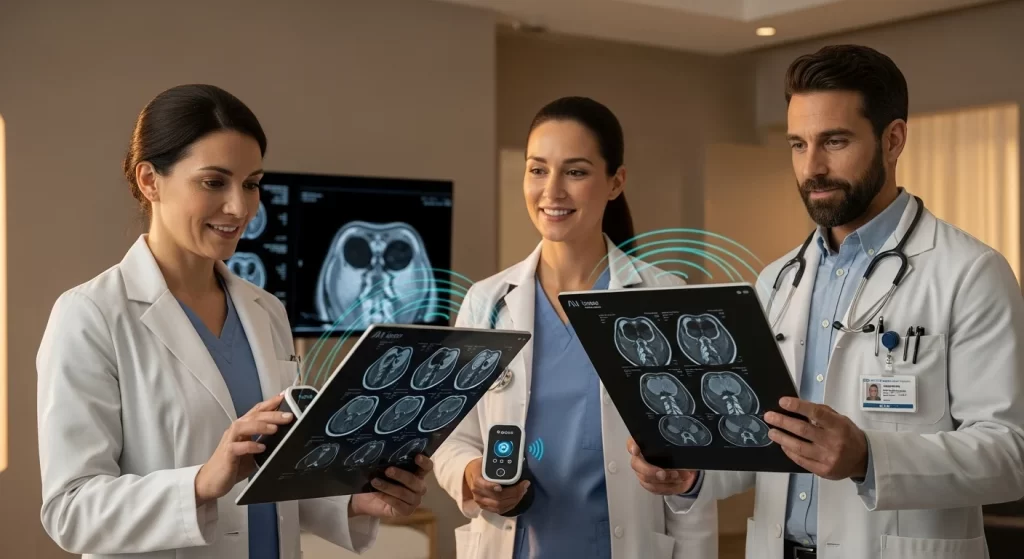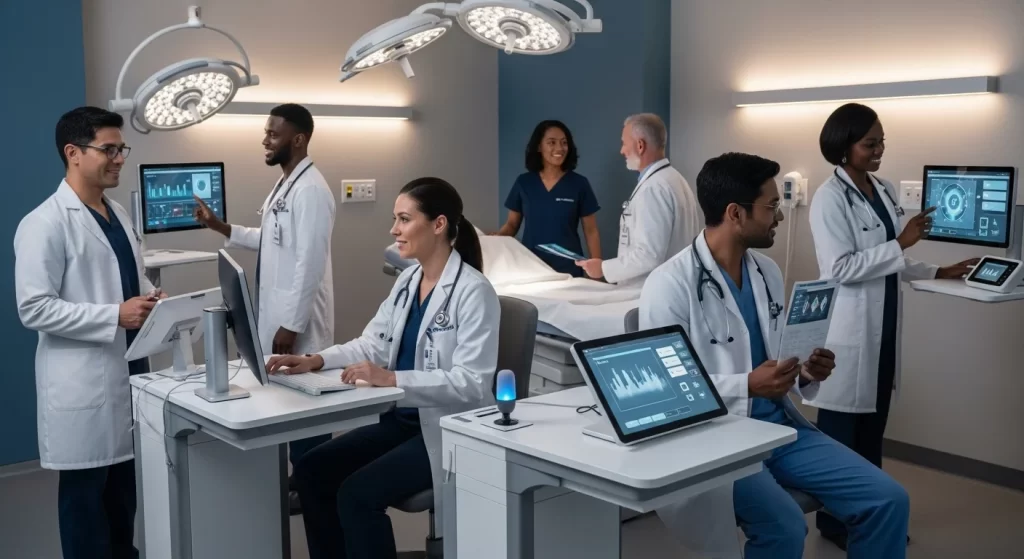The healthcare sector faces escalating demands and administrative burdens that divert clinicians from patient care, contributing to widespread burnout among healthcare professionals. As 2025 approaches, innovative solutions are crucial. Voice AI in healthcare is emerging as a revolutionary solution to reshape clinical operations by automating routine tasks.

The “invisible assistant” concept describes how voice AI seamlessly integrates into daily routines, providing real-time support, capturing critical data, and streamlining workflows without disrupting clinician-patient interaction. The core objective is to empower clinicians, allowing them to focus on the human element of care.
This article will explore current clinician workflow challenges, explain how healthcare voice AI functions, detail its transformative applications, quantify its benefits for efficiency and well-being, and address key implementation considerations. Finally, it will project future voice AI healthcare trends in 2025 and beyond.
Ready to improve your healthcare operations with intelligent voice AI? SPsoft brings vast expertise in creating AI voice solutions that empower clinicians!
The Current Landscape: Navigating Clinician Workload Before Voice AI
Before the advent of advanced voice AI, clinicians faced significant administrative tasks and communication inefficiencies, which impacted patient care and contributed to burnout.

The Burden of Manual Documentation
Manual documentation consumes a large portion of a clinician’s workday, often extending beyond regular hours.
Time Spent on Data Entry
Primary care physicians spend nearly two hours on electronic health record (EHR) tasks for every hour of direct patient care. This administrative burden often extends beyond clinic hours, known as “pajama time,” contributing to burnout. In 2023, physicians reported spending 7.9 hours weekly on administrative tasks within their average 59-hour workweek. This extensive documentation fuels burnout and limits time for patient care and personal life, highlighting a critical need for solutions.
Impact on Patient Interaction
Manual input during consultations divides clinician attention between the patient and the computer, affecting presence and engagement. Studies show this divided attention can lead patients to perceive a lack of empathy from their clinicians, even when clinicians believe they are demonstrating it. This disconnect undermines personal connection and trust, emphasizing the urgent need for solutions that re-humanize the clinical encounter.
Table 1. Clinician Time Allocation Before Voice AI
| Activity Type | Average Time Spent (per day/week) | Impact on Clinician & Care |
|---|---|---|
| EHR Tasks (per hour direct patient care) | Nearly 2 hours | Reduces direct patient engagement, increases “pajama time” |
| Administrative Tasks (per week) | 7.9 hours | Contributes to burnout, sacrifices personal time |
| Documentation (per workday) | 84 minutes | Primary driver of workload and cognitive burden |
| Computerized Physician Order Entry (CPOE) | 43 minutes (12.1% of clinic hours in EHR) | Associated with burnout, dissatisfaction, and intent to leave practice |
| After-hours EHR work | Up to 8+ hours/week for 20.9% of physicians | Directly fuels burnout, impacts work-life balance |
Inefficiencies in Clinical Communication and Coordination
Beyond individual documentation, systemic issues in communication and information exchange contribute significantly to workload and potential errors.
Fragmented Information Exchange
Real-time information sharing among healthcare teams, especially during handoffs, is challenging. Communication failures account for over 50% of project errors, causing delays and rework. Information gaps arise from assumptions, losing crucial context like the “why” behind decisions. This fragmentation leads to workflow bottlenecks and unclear responsibilities, particularly in virtual teams.
Patients also face confusion from miscommunication regarding prior authorizations and costs, with over 80% reporting issues. This fragmentation incurs significant systemic costs, including over £1 billion annually in the UK, due to communication gaps, which lead to project delays, budget overruns, and compromised patient safety and experience.
Alert Fatigue and Information Overload
EHR alerts contribute significantly to clinician cognitive overload. Clinicians are inundated with warnings, leading to “alert fatigue,” where critical warnings are missed amidst the noise. This issue, similar to alarm fatigue, is worsened by poor EHR interface design.
Research consistently shows that an overabundance of irrelevant information and excessive alerts increase cognitive load and error rates. For example, a 2013 study found that prescribers accepted only one in a thousand alerts, and a 2018 study judged 40% of overrides to be inappropriate, risking patient harm. This paradox underscores that merely digitizing processes is insufficient; the design and intelligence of these systems must fundamentally change to truly support, rather than hinder, clinical judgment and patient safety.
The Voice AI Revolution: Understanding the Core Technology Shaping Healthcare in 2025
Voice AI in healthcare represents a significant technological leap, moving beyond simple automation to intelligent interpretation and proactive assistance driven by sophisticated machine learning and large language models.

Evolution of Voice AI in Healthcare
Voice AI in healthcare has progressed from rudimentary dictation tools to brilliant, context-aware systems.
From Basic Dictation to Intelligent Interpretation
Voice AI has evolved dramatically beyond simple speech-to-text. Early dictation lacked contextual understanding and required extensive review and revision. Modern advancements in Natural Language Understanding (NLU) and contextual comprehension are transforming voice AI into intelligent interpretation tools.
These systems process complex medical language, jargon, and nuanced patient narratives, actively comprehending meaning and clinical relevance. This cognitive leap enables capabilities like clinical decision support and proactive assistance, transforming the technology from a clerical tool into a sophisticated clinical partner.
The Role of Advanced Machine Learning and LLMs
Large Language Models (LLMs) and deep learning algorithms are the foundational powerhouses behind modern voice AI agents in healthcare. Trained on vast textual data, these models excel at capturing the intricacies of human language, enabling them to understand medical nuances, jargon, and complex patient narratives with remarkable accuracy. Specialized medical LLMs are specifically designed and trained on healthcare-specific data, allowing them to perform sophisticated tasks such as summarizing clinical texts, generating differential diagnoses, and answering complex clinical questions by integrating extensive medical knowledge.
This advanced intelligence enables voice AI to move beyond simple data capture and provide context-aware and clinically relevant insights that augment a clinician’s cognitive abilities. By 2025, advancements will focus on actionable, real-world applications, fostering deeper EHR integration, improving patient outcomes, and driving efficiency.
Core Components of a Modern Healthcare Voice AI System
Modern healthcare voice AI systems are sophisticated platforms comprising several interconnected components that enable their transformative capabilities.
Ambient Listening and Real-time Scribing
Ambient listening technology, utilizing advanced voice recognition and LLMs, passively records and transcribes provider-patient conversations in real time. It automatically generates structured clinical notes, significantly reducing the need for manual data entry. Technical considerations for accuracy include sophisticated audio processing to reduce background noise and filter irrelevant sounds. Privacy is paramount: audio recordings are typically used solely to produce notes and then promptly deleted, with strict safeguards against secondary data use.
Clinicians retain ultimate control, reviewing, editing, and approving all AI-generated documentation before it is saved, ensuring accuracy and accountability. The emphasis on human review and approval underscores the “human-in-the-loop” imperative for trust and safety, thereby mitigating risks such as AI hallucination or misinterpretation. This dual layer of automation, combined with human validation, is vital for building and maintaining trust, as well as facilitating the ethical and safe deployment of AI.
Contextual Awareness and Proactive Assistance
Modern voice AI agents possess advanced contextual awareness, enabling them to understand the nuances of clinical encounters, such as patient history and current complaints. This deep understanding allows them to proactively offer relevant information or suggest actions during a visit, moving beyond simple command-response interactions. Examples include real-time voice-activated data lookups for patient information, drug interactions, clinical guidelines, or research findings at the point of care.
Generative AI voice agents can also triage symptoms, perform daily check-ins for chronic disease management, and act as navigators for patients with complex needs. This proactive capability transforms AI from a passive tool into an active clinical partner. This shift means voice AI anticipates needs, offers relevant information during consultations, and can even initiate patient outreach, improving workflow and patient outcomes.
Integration with EHRs and Clinical Workflows
Seamless integration with existing Electronic Health Records (EHRs), Picture Archiving and Communication Systems (PACS), and other clinical workflows is crucial for the successful adoption of voice AI. This involves utilizing mechanisms such as standardized FHIR (Fast Healthcare Interoperability Resources) APIs for automated patient enrollment and efficient data exchange, as well as Single Sign-On (SSO) for easy access.
The output generated by voice AI, such as structured clinical notes and documented actions, can flow automatically and immediately back into the patient’s EHR, enhancing data accuracy and consistency. This integration optimizes existing workflows, reducing cognitive load for clinicians and eliminating the need to switch between disparate systems, thereby streamlining routines and improving efficiency. Seamless integration underscores the imperative of interoperability for realizing actual AI value. Without robust integration, the benefits of voice AI remain fragmented and complex to scale.
Table 2. Core Components of a Modern Voice AI System
| Component | Key Functionality | Impact on Workflow |
|---|---|---|
| Ambient Listening & Real-time Scribing | Captures and transcribes doctor-patient conversations in real-time, generates structured clinical notes. | Eliminates manual note-taking, allows clinicians to focus on patients, reduces after-hours charting. |
| Contextual Awareness & Proactive Assistance | Understands clinical context (patient history, symptoms) to offer relevant information or suggest actions. | Provides real-time decision support, anticipatory data lookups, and intelligent nudges during consultations. |
| Integration with EHRs & Clinical Workflows | Seamlessly embeds AI output (notes, orders) directly into existing EHRs and other systems via APIs. | Streamlines data flow, reduces cognitive load from system switching, enhances data accuracy and consistency. |
| Advanced Machine Learning & LLMs | Powers NLU, contextual comprehension, and generative capabilities for medical nuances and reasoning. | Enables intelligent interpretation of complex medical language, supports diagnostic reasoning, and automates complex tasks. |
The Invisible Assistant in Action: Transformative Applications of Voice AI Healthcare Trends 2025 in Clinical Workflows
The practical applications of voice AI in healthcare are poised to revolutionize various aspects of clinical workflows, from documentation to patient engagement, making the “invisible assistant” a tangible reality by 2025.

Revolutionizing Clinical Documentation
Voice AI is poised to fundamentally transform how clinical documentation is managed, shifting it from a clerical burden to a streamlined, real-time process.
Automated Note Generation and Charting
Voice AI healthcare trends in 2025 will make documentation largely hands-free, freeing clinicians from the significant burden of manual charting. Advanced tools like Suki and Nuance DAX listen to patient conversations and automatically generate various note types, including comprehensive SOAP notes and discharge summaries. This automation saves clinicians hours daily and ensures greater detail and accuracy, as AI does not experience fatigue.
Notes are generated in real-time, often within minutes, allowing physicians to review and finalize documentation while details are fresh. That fundamentally changes documentation from an “afterthought” to an integrated, real-time process, improving accuracy and accelerating billing cycles. AI for notetaking is among the top five new and emerging AI technologies in healthcare for 2025, showing promise in increasing efficiency and redeploying provider time to direct patient care.
Smart Pre-Visit and Post-Visit Summaries
Voice AI can significantly enhance patient encounters by generating smart pre-visit and post-visit summaries. Before a visit, AI systems synthesize patient data (historical records, test results, questionnaires) to provide clinicians with actionable insights and a preliminary agenda. This proactive preparation saves valuable time during consultation. Post-visit, voice AI generates personalized patient instructions and concise summaries, ensuring patients understand care plans, medication schedules, and follow-up steps.
This interactive approach empowers patients to take a more proactive role in managing their health and improving adherence and outcomes. Generating pre-visit and post-visit summaries extends the value of voice AI beyond in-consultation documentation, optimizing the entire patient journey.
Table 3. Comparison: Traditional vs. AI-Powered Documentation
| Feature | Traditional Documentation (Manual/Typing) | AI-Powered Documentation (Voice AI Scribe) |
|---|---|---|
| Time Spent | High (e.g., 2 hours/hour of patient care, 7.9 hours/week admin, 2-3 hours after-hours) | Significantly reduced (e.g., 3.2 hours/day saved, 50% reduction, 20 minutes daily) |
| Accuracy | Prone to errors, omissions (e.g., 20-30% missed details) | High accuracy (e.g., 94-96% accuracy, 22% more relevant findings) |
| Real-time Capture | Limited; often done after visit | Real-time during consultation |
| Impact on Clinician | Burnout, stress, “pajama time,” less patient focus | Reduced stress, improved work-life balance, increased job satisfaction, more patient focus |
| Cost Implications | High labor costs (physician time, human scribes), potential for claim denials | Lower operational costs (60-70% less than human scribe), faster billing, ROI in 3-6 months |
Enhancing Clinical Decision Support and Information Access
Voice AI empowers clinicians with unparalleled access to information and intelligent support at the point of care, significantly enhancing decision-making.
Voice-Enabled Information Retrieval
Voice AI empowers clinicians with instant, hands-free access to critical information directly at the point of care. Clinicians use simple voice commands to instantly retrieve patient data, review medical history, access drug information, consult clinical guidelines, or look up recent research findings without diverting their attention from the patient or navigating complex EHR menus. This capability integrates seamlessly with extensive medical knowledge bases, providing rapid, accurate answers to complex clinical queries.
This immediate access to comprehensive and relevant information supports better clinical decision-making, reduces delays in care, and ensures that clinicians have the latest evidence readily available during critical moments. Voice-enabled information retrieval democratizes knowledge at the point of care, leading to more accurate diagnoses and safer practices.
Intelligent Order Entry and Referrals
Voice AI agents in healthcare can facilitate verbal order entry for medications, laboratory tests, or imaging, ensuring both accuracy and compliance. This hands-free capability minimizes manual data entry, which in turn reduces the potential for errors commonly associated with traditional computerized physician order entry (CPOE) systems. The efficiency gains from voice-driven order entry are substantial, enabling clinicians to focus on the patient while simultaneously generating precise orders.
Beyond direct orders, AI can also streamline referral processes by capturing verbal instructions and initiating the necessary administrative steps, reducing delays and ensuring patients follow the appropriate pathways. Furthermore, generative AI, in particular, demonstrates significant potential in automating claims processing and prior authorizations, reducing verification times from days to near real-time through the conversion of structured data. Voice-enabled order entry directly addresses CPOE burdens, and automating tasks such as prior authorizations and claims processing has a substantial financial impact.
Streamlining Patient Engagement and Communication
Voice AI plays a pivotal role in enhancing patient engagement and communication, fostering better understanding and adherence to care plans.
Voice-Guided Patient Education
Healthcare voice AI can significantly assist clinicians in verbally explaining complex medical conditions or treatment plans to patients in a clear, understandable, and accessible manner. It can generate personalized patient instructions, medication reminders, and pre-procedure guidance, all tailored to individual patient needs and health literacy levels.
This interactive and accessible approach empowers patients to take a more proactive role in managing their health, improving adherence to treatment plans, and ultimately leading to better overall health outcomes. Voice AI agents can also answer common follow-up questions that patients might have after leaving the clinic, drawing from extensive knowledge bases to provide accurate and consistent information, thereby freeing up staff time. Health literacy challenges are significant barriers; voice AI’s personalized, voice-guided explanations directly address this, improving patient comprehension and adherence.
Automated Follow-up Reminders and Check-ins
Voice AI can automate routine patient follow-up calls, appointment reminders, and symptom check-ins, significantly reducing the administrative load on staff. These automated yet natural conversations can confirm appointments, send medication refill prompts, or provide post-discharge instructions, boosting patient adherence and reducing no-show rates.
This automation frees up valuable human resources, allowing staff to focus on more complex patient needs while simultaneously ensuring continuity of care and improved patient satisfaction through timely and consistent communication. Automated systems can also deliver lab results notifications, bed availability alerts, and high-risk patient flags, keeping both patients and healthcare providers informed in real time. Automating follow-ups and reminders via voice AI allows scalable, personalized outreach to patient populations, reducing administrative burden and improving patient adherence.
Quantifying the Impact: How Voice AI is Redefining Efficiency and Well-being
The adoption of voice AI in healthcare is delivering tangible, quantifiable benefits that redefine operational efficiency, significantly improve clinician well-being, and elevate the overall quality of care.

Dramatic Time Savings for Clinicians
Voice AI is proving to be a powerful tool in reclaiming valuable time for healthcare professionals, directly translating into enhanced productivity.
Measuring Efficiency Gains
The adoption of voice AI in healthcare yields dramatic and quantifiable time savings for clinicians. Studies report that physicians utilizing AI scribes save an average of 3.2 hours per day on documentation tasks, with some reporting a remarkable 50% reduction in documentation time. That translates to clinicians completing their paperwork in an average of 5.11 minutes, compared to 8.9 minutes with traditional typing—a 43% reduction in time. For a typical primary care doctor, this means saving nearly two hours daily.
These solutions also significantly reduce after-hours work, with one multi-specialty clinic reporting a 72% reduction in time spent on documentation outside of regular clinical hours. This reclaimed time represents a substantial shift in how clinicians manage their workload. Consistent time savings highlight the compound effect of reclaimed time across the healthcare system, impacting patient access, clinician well-being, and the financial bottom line.
Increased Patient Volume and Productivity
The time reclaimed from reduced documentation directly translates into the ability for clinicians to either see more patients or dedicate more focused attention to complex cases. Practices utilizing voice AI have reported an average increase of one to three additional patient visits per day per provider, with some clinics adding five patient slots weekly, representing a 20% increase in patient capacity. That not only boosts overall productivity and patient throughput but also allows for deeper patient engagement during consultations, as clinicians are less distracted by charting, ultimately leading to a higher quality of care per visit.
Voice AI helps clinics handle more patients without needing additional staff, making operations scalable and reducing paperwork, allowing for a focus on patient care. It can also improve productivity by 40% and customer satisfaction by 60%. While increased patient volume is a clear productivity gain, organizations must strategically manage the reclaimed time to avoid negating the benefits of burnout reduction.
Combating Burnout and Enhancing Work-Life Balance
Beyond efficiency, voice AI offers a direct pathway to improving the well-being and professional fulfillment of healthcare professionals.
Direct Impact on Clinician Well-being
The adoption of healthcare voice AI is directly linked to a significant reduction in clinician burnout, decreased stress levels, and improved job satisfaction. Surveys indicate a 61% reduction in documentation-related stress and a 54% improvement in work-life balance for clinicians using AI scribes.
Users of Microsoft’s Dragon Copilot reported a 70% reduction in feelings of burnout and fatigue. Other studies show a 63% reduction in burnout and a 64% improvement in work-life balance among providers. That addresses a critical issue, as heavy administrative workloads are identified as a primary driver of burnout, affecting nearly 50% of doctors nationwide. The positive shift in these metrics signals a promising trend in physician well-being since the COVID-19 public health emergency, with burnout rates dropping below 45% in 2024. The direct correlation between voice AI and reduced burnout makes AI a critical tool for workforce retention.
Boosting Professional Fulfillment
By freeing clinicians from the clerical drudgery of documentation, voice AI allows them to refocus their energy on the more rewarding and human-centric aspects of medicine: direct patient interaction, complex problem-solving, and compassionate care. This fundamental shift enhances professional satisfaction and fulfillment, effectively moving clinicians away from being perceived as “data entry clerks” and back to their core role as “healers.”
The ability to give undivided attention to patients, as reported by 90% of clinicians in one study after adopting ambient clinical documentation, directly contributes to this renewed sense of purpose and job satisfaction. When clinicians are less distracted by administrative tasks, they can engage more deeply, listen actively, and build stronger therapeutic relationships, which are core to professional fulfillment in medicine. Beyond time savings, the core benefit is improving clinician work life and professional experience, fostering fulfillment and leading to more empathetic, higher-quality care.
Elevating Care Quality and Operational Excellence
The impact of voice AI extends beyond individual clinician benefits, contributing significantly to overall care quality and the financial health of healthcare organizations.
Improved Documentation Accuracy and Compliance
Voice AI healthcare trends in 2025 will significantly contribute to more complete, accurate, and standardized clinical notes. By capturing detailed and accurate notes in real-time directly from spoken interactions, AI reduces the chance of mistakes and improves overall data quality within patient records. Studies show that AI medical scribes achieve 94-96% accuracy in clinical documentation, notably outperforming traditional physician-created notes, which often miss 20-30% of relevant details due to time constraints.
This enhanced accuracy also extends to compliance: voice AI can help ensure adherence to medical coding and billing requirements by suggesting appropriate diagnostic and procedure codes during patient encounters, thereby minimizing claim denials and reducing audit risks. Furthermore, AI-powered transcription tools reduce documentation errors by 47% and improve response times. Improved documentation accuracy and completeness yield a “data integrity dividend,” leading to better clinical decision-making, reduced medical errors and enhanced patient safety.
Financial Benefits for Healthcare Organizations
The economic advantages of integrating voice AI in healthcare are substantial and far-reaching. U.S. healthcare providers may save approximately $12 billion annually by 2027 due to the increased efficiency that voice technology provides. That includes significant reductions in administrative overhead, optimized billing processes, and faster claims processing, as AI automates time-intensive tasks such as prior authorizations and benefits verification. Many practices report reaching a return on investment (ROI) breakeven point within a remarkably short period, typically three to six months of implementation.
Additionally, the improved clinician retention rates resulting from reduced burnout contribute to long-term financial stability by lowering recruitment and training costs associated with staff turnover. Voice AI’s ability to automate patient billing inquiries can also significantly reduce operational costs while maintaining or improving patient satisfaction. Quantifiable financial benefits demonstrate that voice AI is a strategic investment, driving financial resilience and enhancing resource allocation.
Table 4. Quantifiable Benefits of Voice AI in Healthcare
| Benefit Area | Key Metric/Finding | Source/Impact |
|---|---|---|
| Time Savings | Average 3.2 hours/day saved on documentation; 50% reduction in documentation time; 43% time reduction in paperwork. | Reclaims significant clinician time for patient care or improved work-life balance. |
| Productivity/Patient Volume | Average increase of 1-3 patient visits/day per provider; 20% increase in patient slots weekly. | Enables higher patient throughput or more focused complex care. |
| Burnout Reduction | 61% reduction in documentation-related stress; 70% reduced feelings of burnout/fatigue; 63% reduction in burnout. | Directly addresses a major driver of clinician dissatisfaction and turnover. |
| Job Satisfaction/Well-being | 54% improvement in work-life balance; 47% increase in job satisfaction; 90% clinicians give undivided attention to patients. | Fosters professional fulfillment and improves quality of life for clinicians. |
| Documentation Accuracy | 94-96% accuracy for AI scribes; reduces errors by 47%; 22% more relevant clinical findings. | Leads to more complete, reliable patient records, enhancing clinical decision-making and compliance. |
| Financial Savings | U.S. healthcare providers may save ~$12 billion annually by 2027; ROI breakeven in 3-6 months. | Reduces administrative overhead, optimizes billing, improves clinician retention. |
The Road Ahead: Future Voice AI Healthcare Trends 2025 and Beyond
The evolution of voice AI in healthcare is dynamic, with emerging capabilities and broader impacts on the entire healthcare ecosystem and policy landscape.

Next-Generation Capabilities
The future of voice AI in healthcare promises increasingly sophisticated capabilities that will further integrate and enhance clinical practice.
Multimodal Voice AI Agents
The future of voice AI in healthcare will increasingly involve multimodal capabilities, combining audio input with other data streams for a more holistic interpretation and automated note-taking. That includes integrating visual cues from patient examinations, biometric data from wearables, and even physiological sensors to provide a comprehensive view of the patient.
By synthesizing diverse data types—such as text from electronic health records (EHRs), spoken interactions, video observations, laboratory results, and vital signs—multimodal AI can provide a more comprehensive picture of a patient’s condition. That leads to more accurate diagnoses, personalized treatment plans, and proactive identification of potential issues, moving AI beyond a single-function tool to a comprehensive diagnostic and monitoring assistant. The evolution to “multimodal” AI signifies a profound convergence of disparate data sources, creating a richer, holistic “digital twin” of the patient.
Proactive Clinical Nudging and Real-time Insights
Voice AI healthcare trends in 2025 will enable systems to provide clinicians with subtle, real-time “nudges” or crucial insights directly during a consultation. Based on the spoken context and integrated patient data, the AI could proactively flag critical information (e.g., “Patient’s last potassium level was low,” or “Consider X medication for this symptom”) or suggest relevant actions. This predictive analytics capability embedded within conversational AI will significantly enhance clinical decision support at the point of care, leading to more timely and informed interventions.
Such systems can also triage symptoms, perform daily check-ins for chronic disease management, and escalate concerns to clinicians, acting as virtual partners in patient care. Proactive clinical nudging directly addresses information overload and alert fatigue in EHR systems, transforming AI into a “cognitive co-pilot” that reduces mental burden and enhances patient safety.
Emotion Recognition and Empathy in AI
Future voice AI in healthcare could evolve to detect emotional cues from both patient and clinician voices, allowing systems to adapt interactions or flag distress. This emerging field, known as affective computing or artificial emotional intelligence, aims to understand, interpret, and respond to human emotions through the analysis of various vocal features such as tone, speed, and pitch, as well as facial expressions and other biometric signals.
While offering significant potential for mental health support, providing more empathetic interactions, and adapting communication styles, careful consideration of ethical implications, patient privacy, and potential biases in training data is crucial. Ensuring transparency about data collection and use, implementing strict guidelines for handling emotional data, and continuously validating AI algorithms against diverse patient populations are essential steps. Emotion recognition in AI pushes technology into an ethically complex frontier, requiring parallel evolution of ethical frameworks.
Impact on Healthcare Ecosystem and Policy
The widespread adoption of voice AI will have significant ripple effects across the broader healthcare ecosystem, influencing standardization, regulation, and global accessibility.
Standardization and Interoperability
The increasing adoption of voice AI healthcare trends in 2025 will further drive the critical need for standardization of medical vocabularies and robust interoperability standards across the industry.
Frameworks like FHIR (Fast Healthcare Interoperability Resources) and HL7 will become even more indispensable for ensuring seamless data exchange between voice AI systems, Electronic Health Records (EHRs), and other clinical applications. FHIR, with its modern REST APIs and standardized resources for patient, lab, medication, and appointment data, is particularly poised to facilitate the rapid adoption and integration of AI solutions across diverse platforms, enabling a common language for health data exchange.
This standardization is essential for AI to access and process comprehensive, consistent data, which is vital for its effectiveness in clinical decision support and workflow optimization. Interoperability, a long-standing challenge in healthcare, becomes an absolute necessity with the advent of AI, accelerating FHIR adoption and driving systemic improvements.
Regulatory Evolution for Voice AI as Medical Devices
New regulatory frameworks and updates are anticipated to govern the clinical deployment and validation of voice AI agents in healthcare, reflecting the unique challenges posed by these evolving technologies. Regulatory bodies, such as the FDA, are already issuing draft guidance on how AI can be applied across the drug lifecycle and in medical devices, emphasizing transparency, credible oversight, and rigorous validation.
These frameworks will focus on ensuring the safety, efficacy, and accountability of AI systems, particularly as they continuously learn and evolve (a phenomenon known as “algorithmic drift”). That necessitates predetermined change control plans and robust lifecycle monitoring to track AI performance long after initial approval, ensuring that evolving algorithms remain trustworthy and effective in clinical settings. Rapid AI innovation presents a “regulatory catch-up” challenge, requiring adaptive frameworks and complex collaboration between innovators and regulators.
Global Adoption and Accessibility
Voice AI in healthcare is projected for significant global adoption, with the U.S. Artificial Intelligence in the healthcare market estimated at USD 13.26 billion in 2024 and projected to grow at a CAGR of 36.76% from 2025 to 2033, reaching USD 221.09 billion. This technology will play a crucial role in improving accessibility to care, especially in underserved regions or for patients with communication challenges. By enhancing telehealth solutions and remote patient monitoring, voice AI can bridge geographical gaps, making healthcare more convenient and accessible to broader populations, including those in rural or remote areas.
The global conversational AI in healthcare market is expected to reach USD 48.87 billion by 2030, reflecting a compound annual growth rate (CAGR) of 23.84%. This widespread adoption is driven by the demand for accessible, cost-effective, and convenient healthcare services, with virtual assistants emerging as a dominant segment. Impressive market projections highlight voice AI’s potential as an “equalizer” for healthcare access, fostering inclusivity and contributing to more equitable and universally accessible care.
Conclusion
The voice AI healthcare trends in 2025 are fundamentally reshaping clinical workflows, ushering in a new era of efficiency, accuracy, and operational excellence. This technology is a powerful catalyst for systemic change across the healthcare ecosystem, addressing long-standing challenges and streamlining data-driven operations.
This transformation offers a profound dual benefit: it significantly reduces clinician burnout by automating administrative tasks and empowers healthcare professionals to reclaim time and energy. That allows them to dedicate more focus, empathy, and expertise to compassionate, high-quality patient care. The “invisible assistant” enables clinicians to be more present and engaged, enhancing well-being and patient outcomes.
SPsoft stands as a committed partner in navigating the implementation of voice AI. Our proven ability to develop and integrate secure, compliant, and highly effective voice AI agents for healthcare is tailored to meet the unique needs of each organization. We are dedicated to seamless integration, optimizing processes, and fostering continuous innovation through collaborative partnerships.
Face the future of healthcare with seamless, intelligent voice AI tools. Learn how SPsoft can design and implement bespoke healthcare voice AI solutions!
FAQ
What is the “invisible assistant” in healthcare?
The “invisible assistant” refers to voice AI technology that seamlessly integrates into clinical workflows to automate routine tasks. It operates in the background, capturing conversations, generating notes, and retrieving data without disrupting the doctor-patient interaction. That allows clinicians to stay focused on patient care rather than on administrative chores, making the technology feel like a silent, helpful partner in the room.
How much time do doctors spend on paperwork?
The administrative burden is significant. Before voice AI, primary care physicians spent nearly two hours on EHR tasks for every one hour of direct patient care, with many spending over 8 hours a week on “pajama time” charting after hours. This documentation overload is a primary driver of stress and burnout, consuming valuable time that could be dedicated to patient care or personal well-being.
Can voice AI understand complex medical conversations?
Yes, modern voice AI has evolved far beyond basic dictation. Powered by advanced Large Language Models (LLMs) trained on vast medical datasets, these systems can understand complex medical jargon, nuances, and patient narratives. That enables the AI to perform intelligent interpretation, generating accurate, structured clinical notes and providing context-aware suggestions during consultations, acting as a sophisticated clinical partner.
How much time can a clinician save using voice AI?
The time savings are dramatic and well-documented. Physicians using AI scribes can save an average of 3.2 hours per day on documentation. Some studies report a 50% reduction in overall documentation time and a 72% decrease in after-hours charting. This reclaimed time allows providers to see more patients—sometimes one to three extra per day—or achieve a healthier work-life balance.
Will using voice AI help reduce doctor burnout?
Absolutely. By tackling the heavy administrative workload, voice AI directly addresses a primary cause of clinician burnout. Surveys indicate that adopting this technology can result in a 61% reduction in documentation-related stress and a 70% decrease in feelings of burnout and fatigue. It allows doctors to shift their focus from clerical tasks back to the rewarding, human-centric aspects of medicine and patient care.
Is AI-generated documentation accurate and safe?
High-quality voice AI systems are designed for exceptional accuracy and safety. AI medical scribes can achieve accuracy rates of 94-96%, often capturing more relevant details than manual notes. To ensure safety, clinicians always remain in control with a “human-in-the-loop” model, where they review and approve all AI-generated documentation before it’s finalized in the EHR. This mitigates risks and ensures accountability.
What is the financial benefit of implementing voice AI?
The return on investment is substantial. U.S. healthcare providers could save an estimated $12 billion annually by 2027 through voice AI-driven efficiencies. Practices often see a full return on investment within just three to six months. These savings come from reduced administrative overhead, optimized billing through improved coding accuracy, faster claims processing, and lower staff turnover costs resulting from reduced burnout.
Can voice AI do more than take notes?
Yes, its capabilities extend well beyond documentation. Voice AI can provide real-time clinical decision support by fetching patient data, drug information, or clinical guidelines with simple voice commands. It can also streamline workflows by facilitating voice-enabled order entry for labs and medications, automating patient follow-up reminders, and generating pre-visit summaries to better prepare clinicians for appointments.
What’s next for voice AI in healthcare?
The future is multimodal. Soon, voice AI will integrate with visual cues from exams and data from wearable devices for a more comprehensive patient view. Expect proactive “clinical nudges,” where the AI offers real-time suggestions during a consultation. Emotion recognition may even allow AI to detect distress in a patient’s voice, though this raises important ethical considerations that must be addressed.
How does voice AI improve the patient experience?
By handling the documentation, voice AI allows clinicians to give their undivided attention to the patient. That eliminates the distraction of typing into a computer during consultations, fostering a stronger personal connection and improving trust. Patients perceive a higher level of empathy and engagement. Furthermore, AI can generate clear, personalized post-visit summaries and instructions, improving patient understanding and adherence to care plans.



